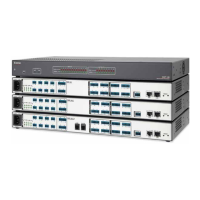Selecting Mix-points
Mix-points are controlled by their address. Each mix-point in figure94 has an individual
address selected and controlled using SIS commands. (A mix-point contains a level
control and a routing control that mutes or unmutes the signal path from the input
mix-point to the output.)
For example, to view the current status of the input 1 to output 1 mix-point
(SIS address:20000) enter:
EMX6)*AU} or EM20000*AU}
The response from the DMP128 is:
DsM20000*1AU} if the mix-point is muted, or
EM20000*0AU] if the mix-point is unmuted, connecting the mix-point input with its
output.
To select a mix-point to view its current signal level setting:
EGX6)AU}.
If looking at the same input 1 to output 1 mix-point, enter:
EG20000AU} or
where 20000 is the mix-point. The response is:
DsG20000*1948] .
Using the table 2 cross-reference on page 149, the mix-point is set to -10dB.
Signal Routing
Mix-point routing is achieved by unmuting the mix-point. To select a mix-point, use the
tables starting on page 175 to find a specific mix-point. In this example, input 1 is routed
to output 1.
Connecting a mix-point input to an output requires the mix-point be unmuted. Using the
formula from above where X6) is the mix-point, to unmute any processor or mix-point use
the command:
EMX6)*0AU}.
The input 1 to output 1 mix-point address according to table 3 on page 175 is 20000
making the correct formula
E
M20000*0AU}. This routes input 1 to output 1.
To break the signal, use the mute formula:
EMX6)*1AU} or EM20000*1AU}.
In this manner any mix-point can be selected and a connection made between its input
and output, or if a connection has already been made, it can be broken.
DMP128 • Reference Information 171

